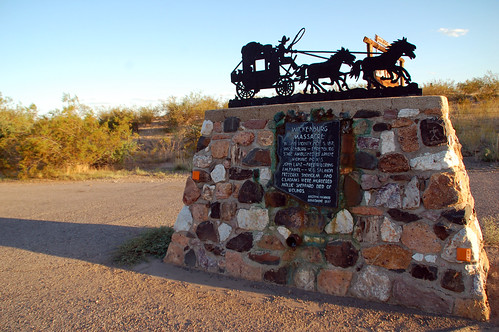
This monument commemorates the Wickenburg Massacre. On November 5, 1871, a group of Yavapai Native Americans attacked a stagecoach bound for California outside the town of Wickenburg in what was then the Arizona Territory. They killed six men on board and injured a woman and another man. The attack was likely in response to any number of injustices committed against the Native Americans, most likely the recent killing of 135 Arivaipa Apache at Camp Grant near Tucson.
Some famous names come into play in relation to the Massacre. Up-and-coming Boston writer Frederick Wadsworth Loring was among those killed; the incident was also known as the Loring Massacre. Some in the northeast had been inclined to sympathize with the southwestern Indians, but, in killing a Bostonian, national sentiment turned against the Yavapai. Initially, people questioned whether they were really Indians or Mexicans in Indian costumes. The killers used guns, but P.M. Hamel was also scalped. Here's an excerpt from The November 11, 1871 Journal-Miner:
"Five men, Messrs. Loring, Shoholm, Lanz, Hamel, and Salmon, who, eighteen hours previous left Wickenburg full of life and hope in the happy anticipation of soon again greeting their friends after a prolonged absence, lay side by side rigid in death and drenched in blood; the unavenged acts of a murder as dark and damnable as ever stained the hands of an assassin."
Famed Indian hunter, General George Crook, investigated the incident, but when he couldn't identify the actual perpetrators, he resorted to the usual form of frontier justice and sent Captain J.W. Mason to attack the Yavapai near Burro Creek. Many Native Americans died in the ensuing battle.
You can read a lot more about the Wickenburg Massacre here or here. The monument sits on Route 60 outside of Wickenburg, but apparently the actual site is off 60 down a dirt road.

No comments:
Post a Comment